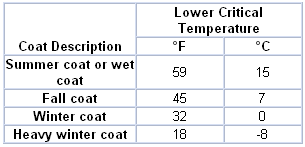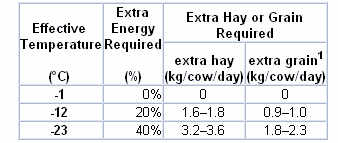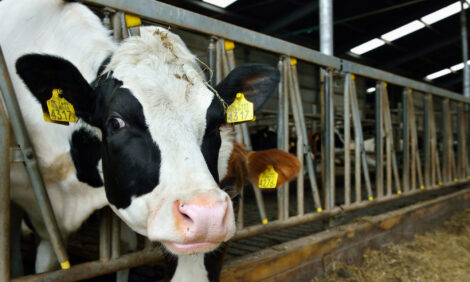



Cold Stress in Cows
By Brian Tarr, Ruminant Nutritionist and reviewed by Craig Richardson, Animal Care Specialist, OMAFRA, and Christoph Wand, Beef, Sheep and Goat Nutritionist, OMAFRA,What Is Cold to a Cow?
When temperatures start to decline in winter, particularly as we get closer to 0°C (or 32°F), it is time to think about what effect this is having on cow productivity and efficiency.Like all mammals, cows are warm blooded and need to maintain a constant core body temperature. Normal rectal temperature for a cow is around 38°C (101°F).
Within a range of environmental temperatures called the “thermoneutral zone,” animals do not have to expend any extra energy to maintain their body temperature. At the lower end of this range, normal metabolic processes supply enough heat to maintain body core temperature. Within their thermoneutral zone, animals may modify their behaviour, such as seeking shelter from wind, and respond over the long term by growing a thick hair coat for winter, without affecting their nutrient requirements. However, below the lower limit of the thermoneutral zone, in the “lower critical temperature,” the animal experiences cold stress. To combat cold stress, the animal must increase its metabolic rate to supply more body heat. This increases dietary requirements, particularly for energy. Typical lower critical temperatures for beef cattle are affected by a number of factors. Table 1, below, shows the impact that different hair coat types can have on lower critical temperature.
Table 1. Lower Critical Temperatures for Beef Cattle,
Assuming No Wind Chill
Assuming No Wind Chill

Cattle, like humans, actually experience the “effective temperature,” which takes into account both air temperature and the effect of wind chill. Cool or cold wind passing over an animal draws heat away from it much more quickly than still air at the same temperature. Wind chill effects for cattle are shown in Table 2, below. These figures assume a dry, clean hair coat. If the animal is wet and/or dirty, consider the data to be an underestimation of the effect of the wind.
Table 2. Wind Chill Effects for Cattle With Winter Coats (values are effective environmental temperatures)1,2.

- Assumes that hair coat is dry and clean.
- For example, when air temperature is –18°C and wind speed is 24 kph, the effective temperature experienced by the animal is the equivalent of a still air temperature of –26°C.
Factors Affecting an Animal’s Ability to Withstand the Cold
- Acclimation: Cattle do adjust or acclimate to colder weather by growing a longer, thicker coat. This provides additional insulation against cold weather. The coat must be clean and dry to provide maximum protection to the cow. Dirt or moisture on the coat reduces its insulation value dramatically.
- Fat Layer: Cattle in good condition with a thick fat layer are better able to withstand the cold than thin cattle. The fat layer acts as another insulating layer between the animal’s core and the environment.
- Metabolic Rate: Cows will also increase their metabolic rate to increase heat production and help maintain body temperature. This increases the need for dietary energy, so appetite is usually increased and cows eat more.
The Effects of Severe Cold Stress on Cattle
Hypothermia occurs when the body temperature drops well below normal. In general terms, with cattle, mild hypothermia occurs with a body temperature of 30°C–32°C, (86°F–89°F), moderate hypothermia at 22°F–29°C, (71°F–85°F) and severe hypothermia below 20°C (68°F). As rectal temperature drops below 28°C (82°F), cows are not able to return to normal temperature without assistance through warming and the administration of warm fluids. As hypothermia progresses, metabolic and physiological processes slow down, and blood is diverted from the extremities to protect the vital organs. Teats, ears and testes are prone to frostbite. In extremes, respiration and heart rate drop, animals lose consciousness and die.In most situations, a more insidious and costly problem occurs. Cows are subjected to an environmental temperature below the lower critical temperature, but without obvious signs of hypothermia. This increases the maintenance energy requirement of these animals as they adjust to the conditions and divert more energy to maintaining body temperature.
There are two potential responses to this situation.
1. Cows have access to higher quality feed and/or increased intake, and therefore maintain their body weight.
Cows try to increase feed intake in an effort to meet their energy requirements. Given the opportunity and gut capacity, cows will eat more feed to help meet their increased energy demands. Practically, it is usually expedient to feed grain as well. This increases feed costs, increasing the cost of keeping cows, however the expectation is that cows will maintain their body weight!
It is generally accepted that for every 1°C drop below the lower critical temperature, there is an approximately 2% increase in energy requirements. The amounts of additional feed required for a cow under cold stress can be calculated, but as a rule of thumb, a cow with a dry winter coat should be fed the additional feed as presented in Table 3, below.
Table 3. Effective Temperature and the Additional Feed
Required to Meet the Cow's Energy Requirements
Required to Meet the Cow's Energy Requirements

- Cows may not be able to eat the amount of extra hay required to maintain their body weight and may have to be fed the indicated amount of grain instead of additional hay to meet their energy requirements.
If cows are not fed additional feed or the quality does not allow them to eat enough to meet their additional energy requirements, body mass will be “burned” to produce metabolic heat. These cows lose weight as both feed energy and stored fat are diverted to maintain body temperature and vital functions. Cows in this situation that start to lose weight soon enter a downward spiral — the more weight (fat) they lose, the less insulation they have, the more susceptible they are to further cold stress, and they lose weight even faster.
Cows, and especially heifers that lose weight, calve in poor condition. The consequences are increased calving difficulties, an increase in the number of lighter, weak calves and higher calf mortality. These dams produce a reduced amount of colostrum (of lower quality) and have lower milk production, increased neonatal mortality and reduced growth rate in surviving calves. These cows usually have delayed return to estrus, longer days open and poorer reproductive success.
Key management factors to limit the effects of cold stress
- Monitor the weather. Monitor temperature and increase feeding in response to cold weather. Cows in the last trimester require additional grain feeding during periods when the effective temperature falls below the lower critical level.
- Protect animals from the wind. Wind markedly reduces the effective temperature, increasing cold stress on animals.
- Bed cows well. Providing adequate dry bedding makes a significant difference in the ability of cattle to withstand cold stress.
- Keep cows clean and dry. Wet coats have greatly reduced insulating properties and make cows more susceptible to cold stress. Mud-caked coats also reduce the insulating properties of the hair.
- Provide additional feed. Feed more hay and grain. If wet feeds are fed, make sure they are not frozen.
- Provide water. Make sure cows have ample water available at all times. Limiting water will limit feed intake and make it more difficult for cows to meet their energy requirements. Frozen troughs and excessively cold water seriously limit water intake.
January 2007


